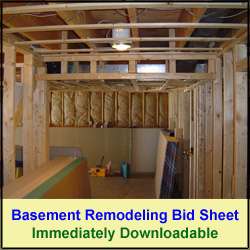How to Detect, Remove, and Prevent Basement Mold
By Mark J. Donovan
|
|
If your basement is damp or occasionally floods, chances are you have basement mold growing in it. Basement mold can damage your home and become a health issue for your family.
Finding Basement Mold To determine if you have basement mold growing in your basement there are number of things you can do. First, simply smell the basement. If it smells moldy, then you more than likely have basement mold growing. It is then just a matter of finding out where it is and getting rid of it. Finding basement mold is not always so easy. |
Conventional building material is ideal for growing basement mold. Basement mold grows easily on wood and paper products, e.g. framing, faced insulation, and drywall.
To find out where the basement mold is growing, pay close attention to the ground level. Check the lower portion of the walls, particularly walls with drywall on them. Basement mold typically grows in dark, cool, moist places, so check behind paneling and drywall, and in basement closets. Also, lift carpets and look under them. Carpet is a great breeding ground for growing basement mold. If you have a dropped ceiling, lift some the ceiling tiles and check for mold growing on the backside of them.
If your basement is frequently damp or wet, then address the problem from the outside. Check that rain water drains away from the home, and if necessary install a perimeter drain around the home’s foundation.
Make sure clothes dryers and basement bathrooms are vented to the outside.
Finally, use fans to circulate air in the basement. Basement mold typically likes to grow in cool, moist, stagnant air.
For more help on Basement Additions, see HomeAdditionPlus.com’s Basement Remodeling Bid sheet. The Basement Remodeling Bid Sheet will help ensure that your hire the right contractor so that your basement remodeling project is done correctly and you get the project finished on time and budget.
Related Information
- How to Waterproof Basement Walls and Floors
- How to Repair Cracks in Concrete Basement Floor
- How to Get Rid of Basement Mold
Get Free Basement Waterproofing Price Quotes with No Obligation!
Fill out our 3-5 minute quick and easy form, and receive a free price quote on waterproofing from one of our prescreened and licensed waterproofing contractors. This process is free and there is no obligation to continue once you receive your waterproofing price estimate.


